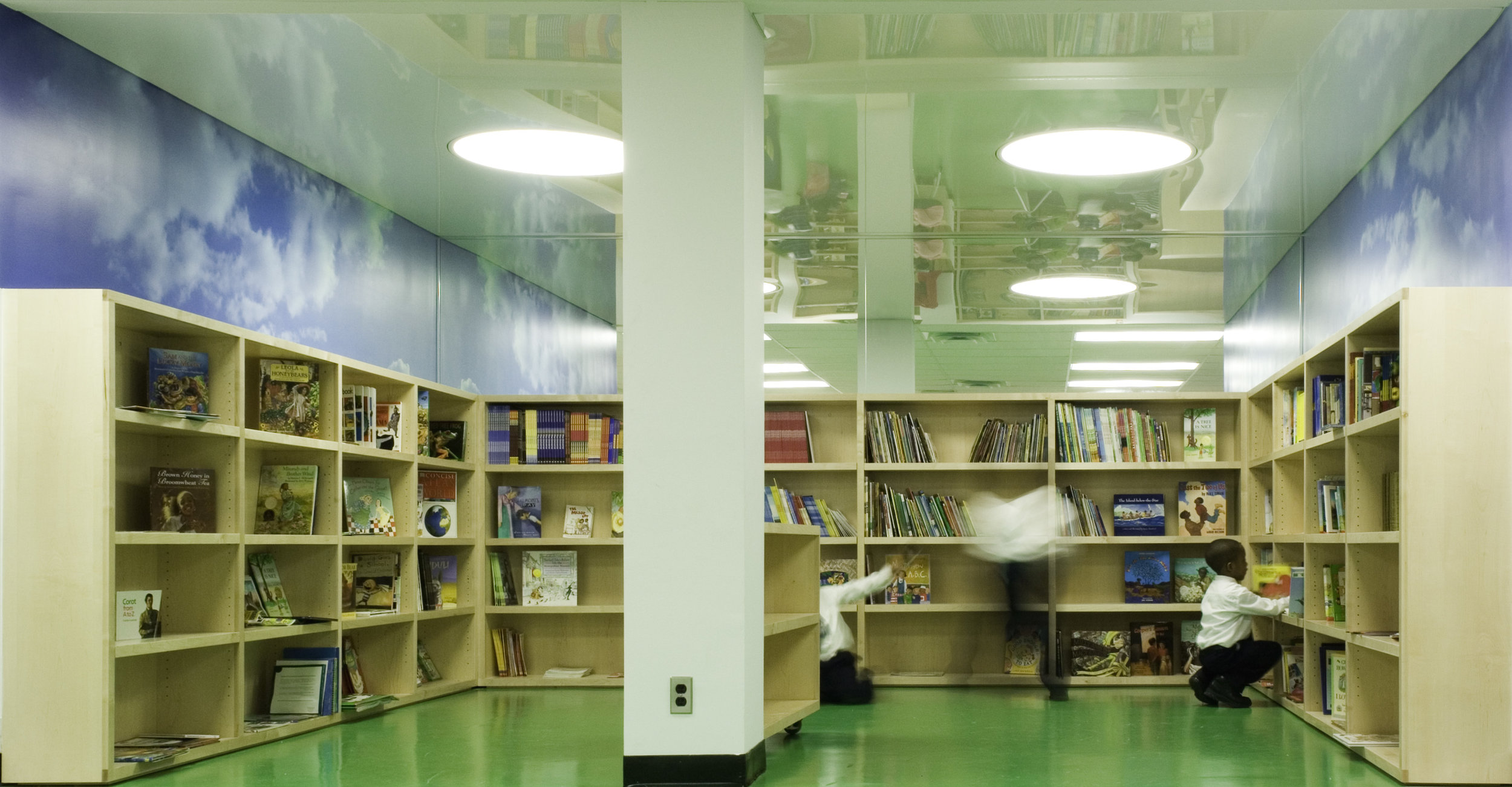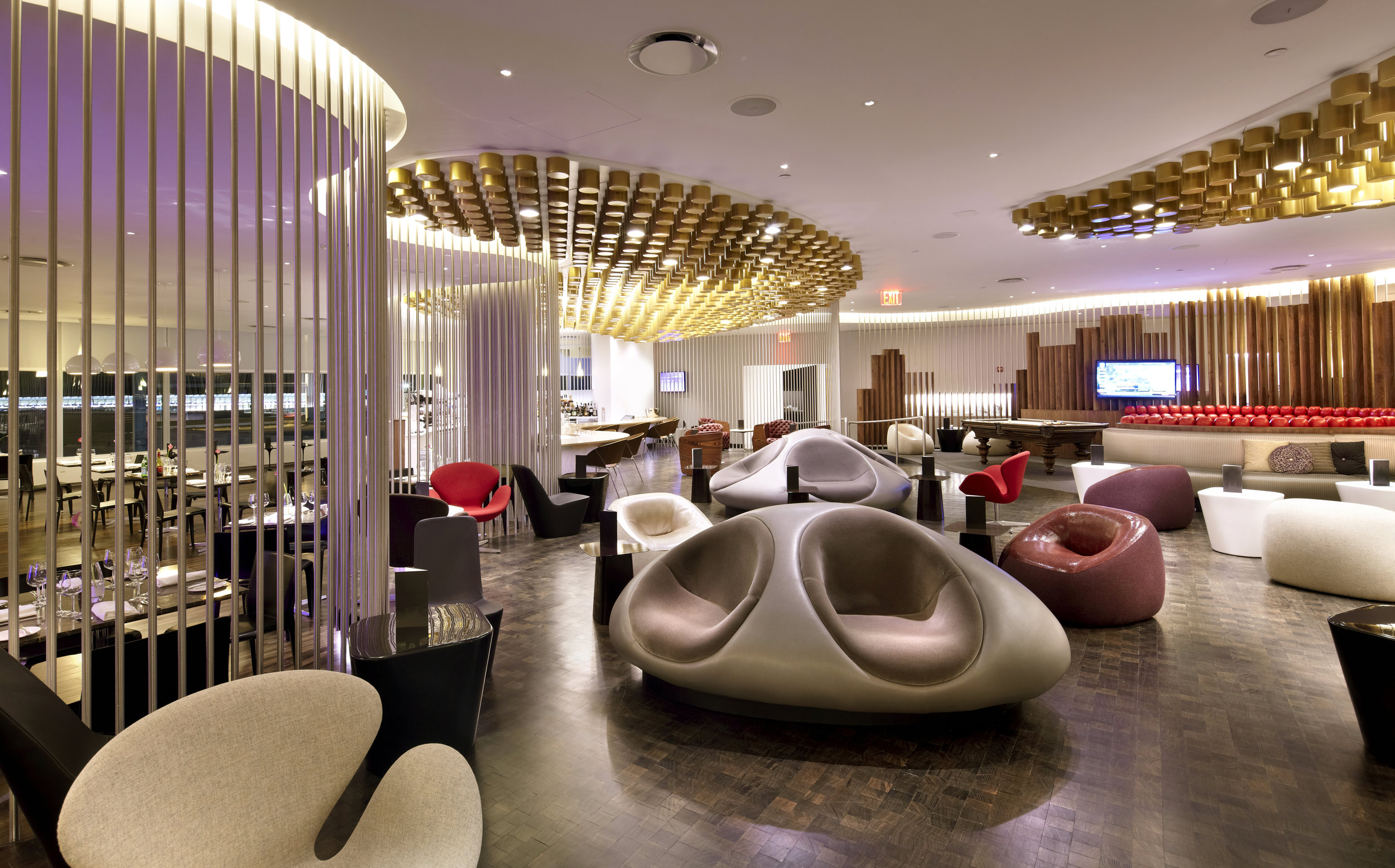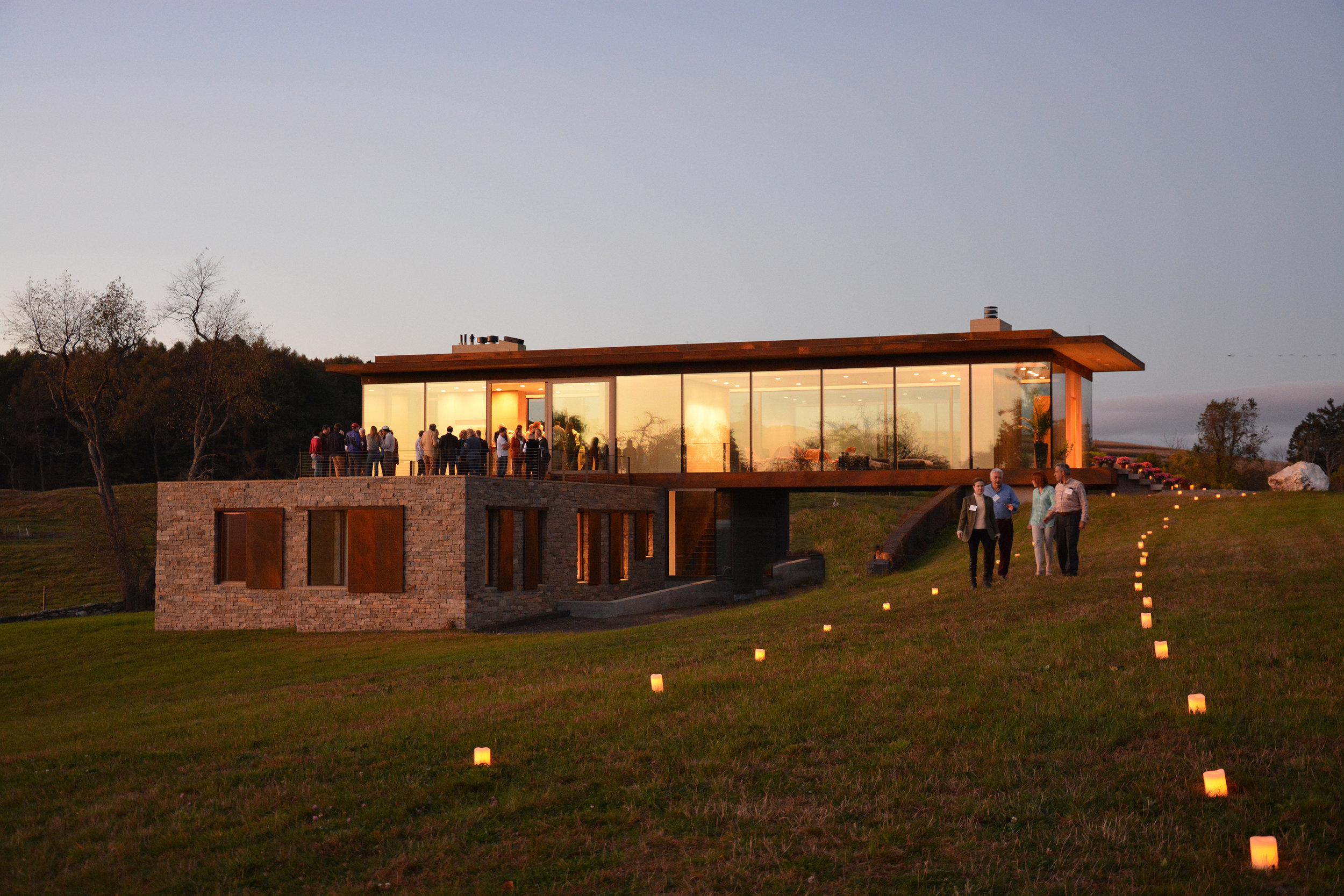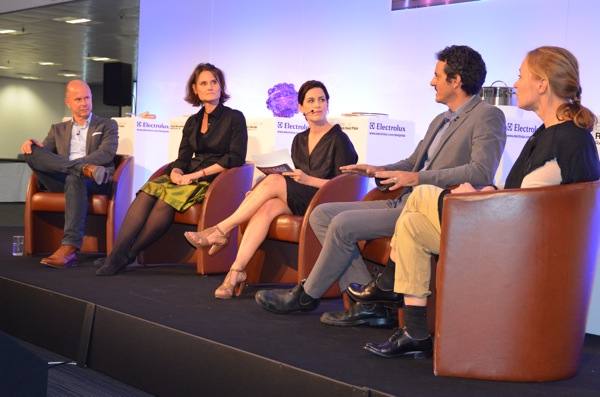Bit by Bit: Hayes Slade on Persistence and Risk-Taking
By Julia Gamolina Hayes Slade is an architect, a founding principal at Slade Architecture, and a mother of four. She is also the upcoming 2019 AIA NY President. In addition to her work at her practice and the AIA, she teaches at Parsons the New School for Design. Hayes brings amulti-faceted background to her design work; she has a Bachelor of Science and Master of Engineering degrees in civil/structural engineering from Cornell University as well as a Master of Business Administration degree from the Wharton School of Business. Prior to Slade Architecture, Hayes worked at Arup in London and NYC, Skidmore, Owings and Merrill in NYC, and the Boston Consulting Group. In her conversation with Julia Gamolina, she talks about how she manages it all, and how she’s learned to stay positive, keep going, and embrace the unplanned and unexpected.
JG: You have such a unique background, you run your own practice, and you are a mother of four! What has been the approach that has made all of this possible?
HS: [Laughs] It’s not any specific approach, I just always had broad interests, recognized things that I got excited by, and then tried to do them. I rarely started out looking ten or fifteen years ahead. I thought “Wow, this would be great to do, I’ll try it,” and then it’s something that evolves over time. I would say my approach was always looking for a challenge and trying to do the most that I can.
Initially, you didn’t set out to be an architect! Where did you start?
I went to Cornell for civil and structural engineering. I’ve always liked to make things and was looking for a field that would draw from a wide range of skills, allow for a creative spark along with technical expertise, and involve all of me. I remember asking about architecture at the time and everyone suggested that engineering, albeit a little different, was the more stable and reliable profession [laughs].
I enjoyed being a structural engineer but was continually drawn to projects where the engineer had a more and more creative role. Eventually I ended up at Arup in London—they work with architects very collaboratively and start early on in the design process. I loved Arup, but kept feeling a little frustrated in my role as engineer. I realized that if I found it frustrating here, at Arup, an amazing environment where you get the most direct view into the creative process, it might just be that engineering isn’t right. The other difficulty was that financial pressures were huge. So, I asked myself, “What might be a broader field and what would make more money?” and the answer was business school!
What was business school like and where did you go from there?
Business school really opened my eyes to how people advocate for themselves. You learn that you may not be 100% sure of what you’re about to say, but if you feel pretty good about it and are honest, you should speak up because you then elicit a reaction and start to move things forward. Business school leads you to a different way of carrying yourself and gets you comfortable with that kind of risk-taking, which then builds confidence.
When I graduated, I worked in strategy consulting at Boston Consulting Group. We were developing new business directions for existing companies – different business models and opportunities they could try. The work was extremely conceptual and interesting, but I was restless and missed making things. I switched to web design, and worked in an interactive agency called Organic. I enjoyed that – we were designing and building things like websites and campaigns, and there was strategy to it—but ultimately, the digital/web product was not entirely satisfying for me.
How did you finally end up in architecture?
My husband James wanted to be an architect since he was little—the opposite of me—and had already started a firm with another partner. We always had the general idea that in the long-term, we would collaborate and have a creative firm together. It was this nebulous idea that would happen at “sometime in the future” when it would clearly be the next logical step. Then, 9/11 happened. We lived right next to Ground Zero, and we were standing right there, watching it all.
9/11 was life changing and got us to think about the future differently. We realized that the future is never certain, there will never be a moment with a clear, logical next step and you don’t even know how much of a future you have. My personal realization from that experience was that if there is something you think you might want to do, you should just try doing it! So, almost exactly a year from 9/11, we started working together. A few years later, I got my architecture license in New York by qualifying my engineering education and work experience, and taking the exams.
What lessons from engineering and consulting have you applied to architecture?
Consulting teaches you that there’s a real benefit to having a fresh perspective and not being entirely familiar with all the ins and outs of something. You can’t be foolhardy or cocky, but to have the confidence to suggest something new, even if everyone is skeptical, is very valuable. Management consulting has a lot of those “a-ha” moments where you need to be open and brave. I’m constantly drawing on that experience in my work now because every time we meet a new client or start a new project, it’s a different challenge.
Engineering teaches you to not be intimidated by complexity. Sometimes when looking at the model analysis, the building code, the budget, and the schedule, it can seem like an impossible problem to solve. In engineering you just have to work your way through to a good solution, to detail down to the number of bolts and the way they’re tightened, for example. It’s against most people’s instincts, to stay in the mud and sludge through, but you develop those habits and it becomes easier and easier. When you’re done, and you’ve done a really thorough job, it feels good. You also learn that short cuts at the beginning are usually not good in the long run [laughs].
What has running a practice been like?
It’s both very rewarding and very challenging. You worry about everything—taking care of staff, winning work, doing good work, closing jobs out well, and winning more work—and you worry about all these things at the same time. On top of that, you’re trying to have balance and live your life. I find the balance to be the ultimate challenge.
Is there any separation between the office and home life when you are in business with your husband?
Not really. We talk about work all the time and everywhere, though we try not to at parent-teacher conferences [laughs]. I think it’s good for the children to see their parents building something together. Obviously the kids are of central, central, importance to us, but I think it’s also healthy for them to see that there are other things going on in the family. Everybody has the things that interest them and everybody has responsibilities—for the children, their responsibility is schoolwork and for us it’s the firm, but we do things together as a family as well.
I hardly know any moms of four, let alone in architecture. Did you always want a big family?
No, we thought we’d have no kids! Then at one point, I was working in London and had a job opening in NY for one year hence, with Arup. We thought that we could have a baby or travel with that time. Almost immediately, I was pregnant [laughs]. Similar to my career trajectory, this wasn’t entirely planned but it worked out wonderfully.
How do you manage it all?
It’s not easy. There have definitely been times when I think, “Oh my god, I can’t believe I forgot to pack them lunch!” But it’s OK—they’ll survive. I’ve also been really lucky–my parents have been incredibly supportive of me and my husband and our family, day after day, and have helped with the children over the years. We never even had a nanny or babysitter! My parents’ time and care is a gift that has been one of the most important to me, and there’s no way to thank them enough.
When we were invited to the design competition for our first Virgin Atlantic Lounge, we found out on a Thursday that we were one of three firms hired for the final, paid ideas phase, and the client wanted to see a full design on Tuesday morning. We basically shipped the kids off to my parents’ place and stayed in the office working from Friday until Tuesday. It was important work for us—fun and a great memory. Sometimes being well slept is overrated if you’re excited, the fatigue is worth it.
Otherwise, I have a workstation set up at home and I bring the kids to the office a lot, I mean a lot. They’ve all spent substantial time here, hanging out, drawing, and doing their homework. The children know everybody in the office and they feel like they’re part of the office too. Our lives are total immersion. Everybody is in it together.
What is the biggest challenge that you’ve faced?
To be the right person that different contexts need me to be. I think people can have a fixed idea of what someone is supposed to be like in the office, on the job site, or at home. I try to be the same person in all these environments and be my natural self. I can’t switch on and off to different personas - nor would I want to. I think this is especially challenging for women.
What are you most proud of?
I’m really proud of and happy with the decision to start the firm with my husband—we had a family, so there was a heightened financial risk for us to work together. I also feel proud that my kids have grown up and that I’ve always been working professionally. There’s temptation at times to stop—everybody has their days when they’re like, “This is IT, this is IT, I’m throwing in the towel!” but then you look back at this thing that you’ve been building for years and years, and it is satisfying and important. There is something to persisting, building a body of work, and being an example of a regular person who is also a mom and an architect.
What is the biggest lesson you’ve learned?
To break down your big challenges into smaller pieces and to look for the good around you. A lot of things are simpler than they initially appear; you just need to analyze them and break them into their component pieces. One small example people face early in their career is the licensing exam—it’s definitely work and it takes discipline, but you just need to get in there and start chipping away. Many of the biggest challenges are just a series of small steps that add up to a bigger thing that only looks monolithic from the outside.
I used to have timelines for my goals, telling myself that “I’m going to get this done by this time, and then after I get more things done, I want to start a family.”
Oh, that’s not going to work [laughs]. I don’t think you can make those kinds of timelines. You’ll drive yourself crazy worrying “is this going to happen before that.” You have to tell yourself: I’m going to do these things in my life, period. Then you’ll have a baby, and you’ll still be trying to do these things, and then the baby will grow up and will see you doing these things. It’s all a continuous effort rather than a series of momentous achievements.
Who have been your mentors?
I meet people every day that I admire and that guide me. Rather than having specific mentors, I’m always looking to learn from the best aspects of each interaction. Our firm collaborates often – internally within the office, with clients, consultants, and other architects – and we learn from people all the time. This profession is incredibly collaborative and does not lend itself to the lone wolf mentality. There’s that stereotype in architecture, the one guy that’s standing in front of the building saying ‘I did this and I did that,’ and I’m thinking “I’m pretty sure that’s not how it went down. I’m pretty sure there was a team involved.” I believe, thankfully, people are starting to recognize that collaboration is critical. Building projects are complex in 2017 and there are a lot of people at the table.
Were you excited when your eldest decided to study architecture?
Absolutely - I was delighted that our son wanted to be an architect. I think it’s a fantastic profession and the architectural education model is really well rounded. You study everything—the environment, history, sociology, construction, materials, and physics. You also go from the very large picture of taking in a lot of information, distilling it into something meaningful to you, and coming up with an overall concept, to then developing a design, proving its feasibility, creating compelling imagery, and advocating on its behalf. I think that that whole process is a critical skill that would be good in any profession. Yes it’s through the lens of a building, but it’s an interesting general approach and process. I think it’s a wonderful background and one of the last whole-brain fields. On a personal level it was maybe a little bit of an endorsement of all the days we kept him in the office. I thought, “Oh good, it wasn’t as bad as I thought.” Maybe the guilt subsided a little bit and came off my shoulders [laughs].
[author] [author_image timthumb='on']http://architexx.org/wp-content/uploads/2018/01/MA.jpg[/author_image] [author_info] With experience in design, business development, PR, and marketing, Julia Gamolina is focused on communicating identity in the built environment. She is a regular contributor to sub_texxt, interviewing women in architecture on their career development. She is also on the Young Leader's Group committee for the Urban Land Institute (ULI), and is a Founding Member of the Wing. Julia received her Bachelor of Architecture at Cornell University, graduating with the Charles Goodwin Sands Memorial Medal for exceptional merit in the thesis of architecture.[/author_info] [/author]









